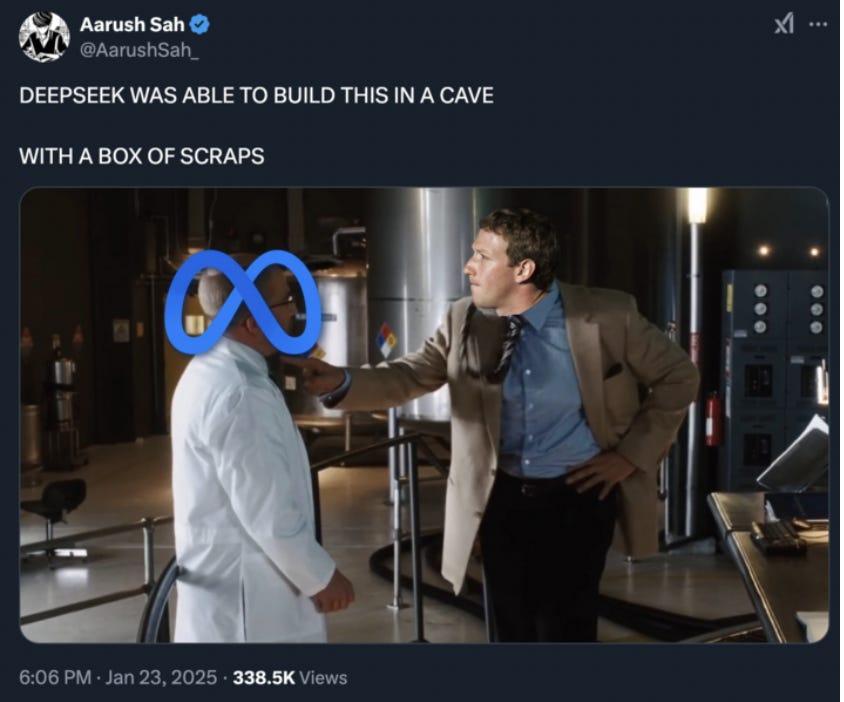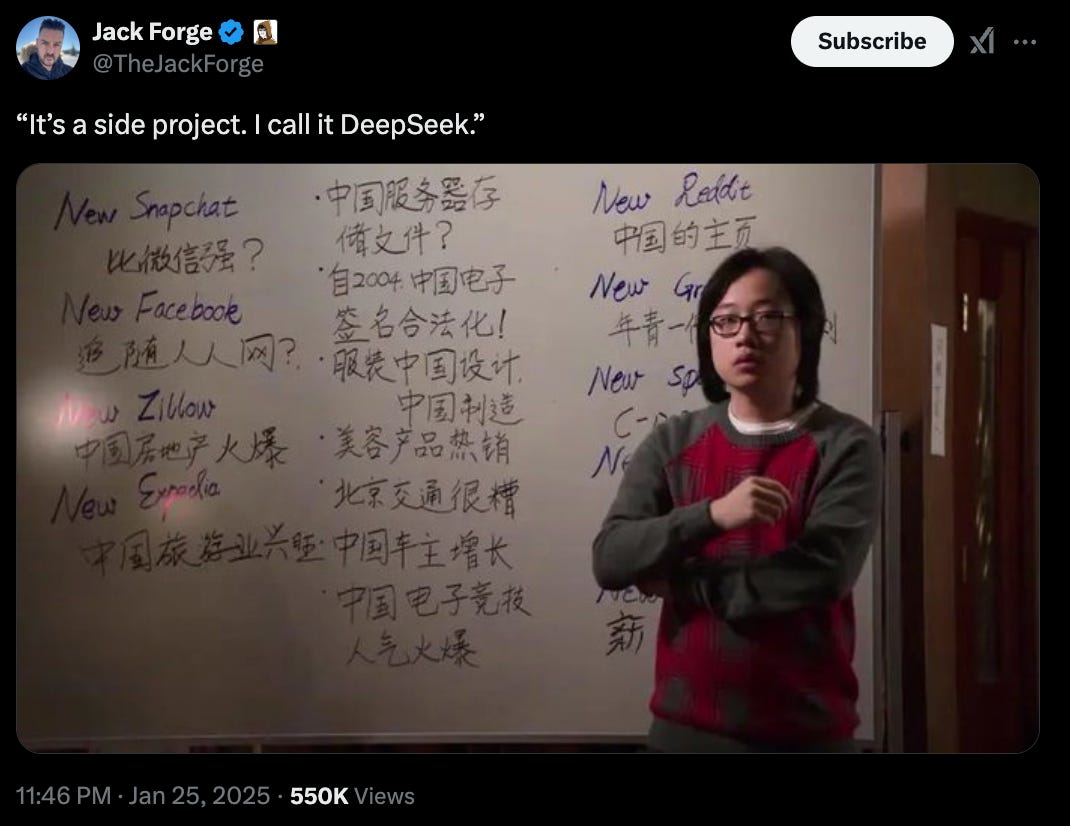Tata dials in, New AI play, and An expensive settlement.
🗓 Morning, and happy Monday!
It is the week of the budget, and the stakes couldn’t be higher.
Markets will actually be open on Saturday, while the Union Budget will be presented. Meantime, this week major Q3 earnings from Tata Steel, Maruti, and ONGC will keep investors on their toes.
Another thing to watch out for is the US Fed's interest rate decision, which could ripple across markets worldwide.
📉 ICYMI: Last week, the Sensex slipped 0.77%, and the Nifty fell 0.50%.
💡 Spotlight: India’s exports rose 5.5% to $59.9 billion during April–December, powered by robust American demand for Indian goods.
And BTW, tomorrow we’ll have a quick update regarding Filter Coffee.
Let’s dive in. ☕
1 Big Thing: The AI race gets a plot twist 🤯
China just dropped a bombshell in the AI arms race, and Silicon Valley is just losing it.
What’s popping: DeepSeek, a virtually unknown Chinese AI lab, built an open-source language model that outperforms heavyweights like OpenAI’s GPT-4o. Virtually overnight DeepSeek is now a top 10 global model across rankings.
Here’s the kicker: DeepSeek took only two months to get to this level, with less than $6 million spent, and was built using downgraded Nvidia chips that the U.S. thought would hobble China’s AI ambitions.
Compare that to the $100 million+ it cost to train something like GPT-4. And all this while hundreds of billions are being spent by US tech to scale AI infrastructure.
Silicon Valley’s panic is palpable. It raises 2 questions:
- If a relatively small lab can do this, what’s stopping China’s AI ecosystem from leapfrogging the U.S.
- Does it even make sense to invest so much on AI infrastructure?
How did they pull this: DeepSeek leaned on an approach called "model distillation"—training a smaller, cheaper model using a large, expensive one. Think of it as a talented apprentice learning the craft by shadowing a master artisan. Efficient, precise, and, as it turns out, game-changing.
The bigger picture is unsettling for Washington. The export controls meant to choke China’s AI progress, and limit access to NVIDIA chips, haven’t exactly worked.
The other side: some of Silicon Valley’s who’s who simply say that China is lying, and that they have in fact gotten their hands on thousands of NVIDIA GPUs but wont let that come out fearing Washington’s scorn.
Meanwhile, analysts say that this could be the Black Swan event that could unravel the NVIDIA trade.
Also, Twitter had a field day with the memes. Some of our favorite ones.


2. Tata steps up iPhone game 📱
Tata has finally closed on its acquisition for a 60% stake in Taiwanese contract manufacturer Pegatron’s iPhone plant in Chennai
Why it matters: Pegatron played a crucial role in helping Apple diversify away from China, but the writing on the wall was clear—manufacturing in India means working closely with local players. Giants like Tata have been jumping on that opportunity.
This acquisition makes Tata the only company outside Foxconn to assemble iPhones in India.
What will it entail: the Chennai plant will employ 10,000 workers and churn out ~5 million iPhones annually.
Tata already owns an iPhone assembly unit in Karnataka (acquired from Wistron) and is building a new facility in Hosur, Tamil Nadu, both dedicated to serving Apple.
The mega trend: India is on track to produce 20-25% of all iPhones sold globally this year, more than doubling its output from last year.
While we are on acquisitions,
LG Electronics is acquiring a 51% stake in California-based Bear Robotics, valuing the startup at $600 million.
Bear builds AI-powered server bots for restaurants, known for managing fleets of robots efficiently. LG plans to integrate Bear’s technology into its existing lineup of home and industrial automation solutions.
Zoom out: as AI becomes more sophisticated and cheaper to access, robotics could take off. Robotics is projected to be a $375 billion market by 2035.
3. Zuck goes all in 🎯
Meta plans to spend $65 billion this year to supercharge its AI infrastructure, as it looks to bring AI features and functionalities across Instagram, Whatsapp, which serve nearly 4 billion people each month.
The deal: the company is adding a 2-gigawatt data center, targeting 1.3 million Nvidia GPUs by year-end—making it one of Nvidia’s top customers.
- FYI, at market rates, that is $39 billion spent on NVIDIA’s GPUs for 2025.
The company also plans to bring 1 GW of computing power online by 2025.
Industry trend: Meta’s bold move is a direct response to AI investments by rivals. Microsoft is spending $80 billion on data centers, and Amazon has $75 billion earmarked for 2025. Zuck wants to ensure Meta stays competitive.
Why it matters: in addition to its apps, Meta’s open-source Llama models, AI chatbots, and Ray-Ban smart glasses will utilise this compute. FYI, Meta’s AI assistant is expected to hit 1 billion users in 2025, up from 600 million last year.
4. The TikTok saga intensifies
In the latest of the TikTok story, Oracle and Microsoft are reportedly in talks to acquire TikTok’s global operations.
The proposed deal would see Oracle take charge of TikTok’s algorithm, data, and updates—aiming to reduce Chinese influence.
Why it matters: TikTok was briefly banned last week after the US Congress labelled it spyware. Trump temporarily brought it online, but lawmakers are still pushing for ByteDance’s full divestment, adding layers of complexity to the joint-ownership plan.
Last week, major names like MrBeast and Perplexity AI floated buyout ideas, fueling more speculation.

Zoom out: TikTok has 170M U.S. users and made over $16 billion in revenue in 2023. The stakes couldn’t be higher.
What else are we snackin’ 🍿
📚 SEBI’s archive: SEBI launched "Dharohar," a digital knowledge repository documenting the evolution of India’s securities market.
💧 Submarine bid: ThyssenKrupp and its Indian partner Mazagon Dock are the sole contenders for India’s $5B advanced submarine project after passing field trials.
🔌 Powering up: Indus Towers, India's largest mobile tower installation company piloted EV charging stations in Gurugram and Bengaluru, marking its entry into the EV charging sector.
👍 Confirmed: Pete Hegseth is the new U.S. Defense Secretary, after VP Vance broke a Senate tie, ending a contentious two-month debate.
That’s a wrap! Don’t let the Monday scaries get to you.
And if you’d like to place your brand on this newsletter, let us know.
Hit that 💚 if you liked this issue.

